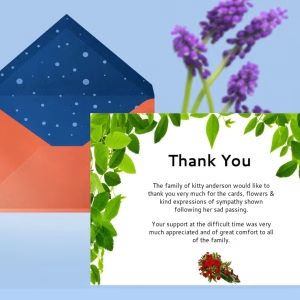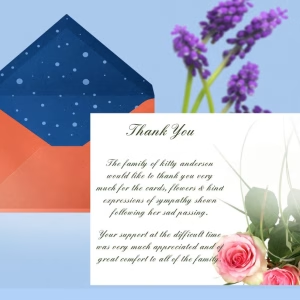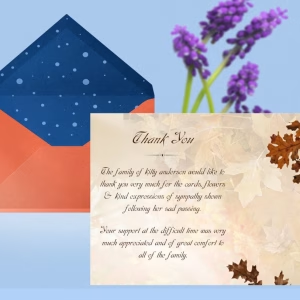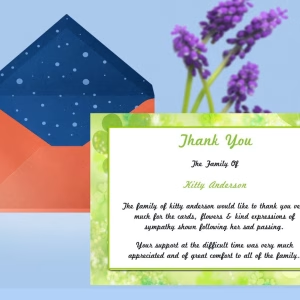In times of grief, expressing gratitude to those who offered support and condolences can be a daunting task. Sympathy thank you cards provide a thoughtful and personal way to convey your appreciation to family, friends, and acquaintances who were there for you during a difficult time. This guide will help you navigate the process of choosing, writing, and sending sympathy thank you cards, ensuring that your sentiments are expressed in a meaningful way.
Why Sympathy Thank You Cards Matter
Sympathy thank you cards are more than just a formality; they are a way to acknowledge the kindness, compassion, and support you received. During a period of loss, people often go out of their way to provide comfort, whether through flowers, food, donations, or simply being present. Sending a thank you card shows that you value their efforts and are grateful for their presence in your life.
The Emotional Impact
Expressing gratitude can be therapeutic. It allows you to focus on the positive aspects of your support network and the love that surrounds you, even in times of sorrow. Writing a thank you note can be a small but significant step in the healing process, offering closure and a sense of connection with those who have shown you kindness.
Social Etiquette
While it’s not mandatory to send sympathy thank you cards, doing so is considered good etiquette. It’s a way to maintain relationships and show that you appreciate the gestures made by others. Even a brief note can leave a lasting impression and strengthen bonds during a time of need.
When to Send Sympathy Thank You Cards
Timing is important, but there’s no strict deadline for sending sympathy thank you cards. Typically, these cards are sent within two to four weeks after the funeral or memorial service. However, it’s understood that grieving takes time, and you should never feel rushed. If it takes a few months to get around to it, that’s perfectly acceptable.
Who Should Receive a Sympathy Thank You Card?
Not everyone who attended the funeral or sent condolences needs to receive a thank you card. It’s common to send cards to:
- Pallbearers: Acknowledge those who took on this important role.
- Clergy or Officiants: Thank them for their guidance and support during the service.
- Friends and Family: Those who provided significant help, such as cooking, hosting visitors, or assisting with arrangements.
- Coworkers and Acquaintances: If they sent flowers, donations, or other tokens of sympathy.
- Anyone Who Sent a Sympathy Card: Especially if the message was particularly touching.
Exceptions to Consider
If you received an overwhelming number of gestures and it feels impossible to send individual thank you cards, consider a general acknowledgment in a newspaper or an online post. While less personal, it’s a way to express gratitude without the burden of writing dozens of notes.
Choosing the Right Sympathy Thank You Card
Selecting the right card is an important step in this process. Sympathy thank you cards come in various designs and styles, from simple and elegant to more personalized options. The key is to choose a card that reflects your feelings and the tone you wish to convey.
Printed vs. Handwritten Cards
- Printed Cards: These cards are pre-printed with a generic message of thanks. They are convenient and can be personalized with a brief handwritten note.
- Handwritten Cards: These cards allow you to write a personal message, making them more meaningful. Handwriting adds a personal touch that printed messages lack.
Design and Style
- Classic and Simple: A minimalist design with a subtle color palette is often appropriate for sympathy thank you cards. These cards focus on the message rather than the design.
- Floral or Nature Themes: Flowers, trees, and other nature motifs can symbolize life and continuity, offering a gentle reminder of the beauty in life.
- Religious Symbols: If faith played a significant role in your loved one’s life, choosing a card with religious imagery or scripture can be fitting.
Crafting the Perfect Message
Writing the message inside a sympathy thank you card can be challenging, especially when emotions are still raw. The key is to keep it sincere and concise. You don’t need to write a lengthy note; a few heartfelt sentences are enough to convey your appreciation.
Basic Structure of a Sympathy Thank You Card Message
- Start with a Greeting: Address the recipient by name.
- Example: “Dear [Name],”
- Express Your Gratitude: Acknowledge the specific gesture or support they provided.
- Example: “Thank you so much for the beautiful flowers you sent. They brought a bit of brightness to a difficult day.”
- Share a Personal Thought: If appropriate, include a brief memory or mention how their gesture made a difference.
- Example: “Your kindness and support during this time have meant the world to our family.”
- Close with a Final Word of Thanks: End with a simple closing.
- Example: “We are deeply grateful for your thoughtfulness.”
- Sign Off: Conclude with a closing phrase and your name or the names of your family members.
- Example: “With heartfelt thanks, [Your Name]”
Examples of Sympathy Thank You Card Messages
- For Flowers: “Dear [Name], Thank you for the lovely bouquet you sent. The flowers were a beautiful tribute and a reminder of the love that surrounds us during this difficult time.”
- For Donations: “Dear [Name], Your generous donation in memory of [Loved One’s Name] touched our hearts. Thank you for honoring their legacy in such a meaningful way.”
- For Attendance: “Dear [Name], Thank you for being there at the service. Your presence brought comfort to our family, and we are grateful for your support.”
- For Support: “Dear [Name], We deeply appreciate the support you provided, from helping with the arrangements to simply being a shoulder to lean on. Your kindness has made a difference.”
Personalizing Your Sympathy Thank You Cards
Adding a personal touch to your sympathy thank you cards can make them even more meaningful. Here are a few ideas to consider:
Including a Photo
A small photo of your loved one can be a touching addition to the card. It serves as a visual reminder of the person who passed away and adds a personal element to the note.
Sharing a Memory
Including a brief memory or anecdote about the deceased can make the card more personal. This could be something that the recipient will appreciate, such as a shared experience or a special quality of your loved one.
Adding a Special Quote or Poem
If your loved one had a favorite quote, poem, or scripture, consider including it in the card. This adds a layer of personalization and reflects the values and beliefs of the deceased.
Sending Sympathy Thank You Cards
Once your cards are written and ready, the next step is sending them out. Here are some tips to ensure the process goes smoothly:
Organize Your List
Before you begin writing, make a list of people who should receive a card. This will help you stay organized and ensure no one is overlooked.
Consider Using Pre-Addressed Envelopes
If you’re pressed for time, consider using pre-addressed envelopes or labels. This can save you the effort of handwriting each address, especially if you have a long list.
Mailing Tips
- Postage: Make sure you have enough postage for each card. If your card is heavier due to photos or other enclosures, you may need additional stamps.
- Timing: While there’s no strict deadline, aim to send your cards within a few weeks to a few months after the funeral. The sooner you send them, the fresher the memory of your loved one will be.
Funeral Thank You Card Template
-
Searching for a Simple Funeral Thank You Card Template that is easy to print and amass and that has a cutting-edge look? This Simple Funeral Thank You Card Template is the Perfect decision that is having a measure of 8.5”x 5.5”.
- No Limitation on Content, Edit anything
- Edit anytime – unlimited revisions even after purchased
- Get printable PDF downloaded to get it printed your own.
-
Searching for a Green Leaf Thank You Card template that is easy to print and amass and that has a cutting-edge look? This Green Leaf Thank You Card Template is the Perfect decision that is having a measure of 5.5”x 8.5”.
- No Limitation on Content, Edit anything
- Edit anytime – unlimited revisions even after purchased
- Get printable PDF downloaded to get it printed your own.
-
Searching for a Natural Thank You Card Template that is easy to print and amass and that has a cutting-edge look? This Natural Thank You Card Template is the Perfect decision that is having a measure of 5.5”x 8.5”.
- No Limitation on Content, Edit anything
- Edit anytime – unlimited revisions even after purchased
- Get printable PDF downloaded to get it printed your own.
-
Searching for a Pink Rose Thank You Card Template that is easy to print and amass and that has a cutting-edge look? This Pink Rose Thank You Card Template is the Perfect decision that is having a measure of 5.5”x 8.5”.
- No Limitation on Content, Edit anything
- Edit anytime – unlimited revisions even after purchased
- Get printable PDF downloaded to get it printed your own.
-
Searching for a Autumn Thank You Card Template that is easy to print and amass and that has a cutting-edge look? This Autumn Thank You Card Template is the Perfect decision that is having a measure of 5.5”x 8.5”.
- No Limitation on Content, Edit anything
- Edit anytime – unlimited revisions even after purchased
- Get printable PDF downloaded to get it printed your own.
-
Searching for a Floral Thank You Card Template that is easy to print and amass and that has a cutting-edge look? This Floral Thank You Card Template is the Perfect decision that is having a measure of 5.5”x 8.5”.
- No Limitation on Content, Edit anything
- Edit anytime – unlimited revisions even after purchased
- Get printable PDF downloaded to get it printed your own.
-
Searching for a Irish Green Thank You Card Template that is easy to print and amass and that has a cutting-edge look? This Irish Green Thank You Card Template is the Perfect decision that is having a measure of 5.5”x 8.5”.
- No Limitation on Content, Edit anything
- Edit anytime – unlimited revisions even after purchased
- Get printable PDF downloaded to get it printed your own.
Funeral Programs : Helping Videos
Frequently Asked Question On Sympathy Thank You Cards
Do I have to send sympathy thank you cards?
No, it’s not mandatory, but sending thank you cards is a thoughtful way to acknowledge the support and kindness you received during a difficult time.
When should I send sympathy thank you cards?
It’s generally best to send sympathy thank you cards within two to four weeks after the funeral, but there’s no strict deadline. If it takes longer, that’s perfectly fine.
Who should receive a sympathy thank you card?
Send cards to those who provided significant support, such as family members, close friends, pallbearers, clergy, and anyone who sent flowers, donations, or meaningful messages.
What should I write in a sympathy thank you card?
Keep your message sincere and brief. Start with a greeting, express your gratitude, share a personal thought if appropriate, and close with a final word of thanks.








